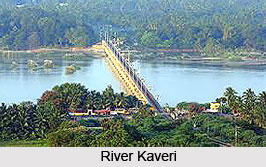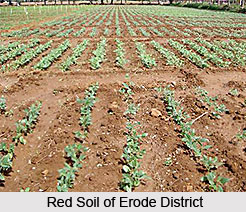 Geography of Erode district is such that it is surrounded by land from all sides and does not have a sea coast of its own. Erode district lies on the extreme north of the state of Tamil Nadu. It is bounded mostly by Karnataka State and also River Palar covers pretty long distance. To the East of this district lies Namakkal and Karur Districts. Dindigal district is its immediate neighbour to the South and on the West; it has Coimbatore and Nilgiri districts, as its boundaries. The region of this district can be portrayed as a long undulating plain gently sloping towards the river Kaveri in the south-east. The three major tributaries of river Kaveri are Bhavani, Noyyal and Amaravathy which drain the long stretch of mountains in the north. A part of the eastern boundary of the district is formed by river Kaveri, entering the district from Salem and flowing in the southern direction.
Geography of Erode district is such that it is surrounded by land from all sides and does not have a sea coast of its own. Erode district lies on the extreme north of the state of Tamil Nadu. It is bounded mostly by Karnataka State and also River Palar covers pretty long distance. To the East of this district lies Namakkal and Karur Districts. Dindigal district is its immediate neighbour to the South and on the West; it has Coimbatore and Nilgiri districts, as its boundaries. The region of this district can be portrayed as a long undulating plain gently sloping towards the river Kaveri in the south-east. The three major tributaries of river Kaveri are Bhavani, Noyyal and Amaravathy which drain the long stretch of mountains in the north. A part of the eastern boundary of the district is formed by river Kaveri, entering the district from Salem and flowing in the southern direction.
Climate of Erode District
Erode in general is characterized with a scanty rainfall and a dry climate. Maximum rainfall is recorded in Gobichettipalayam and Bhavani taluks. The Palghat gap in the Western Ghats, which has a soothing effect in the climate of Coimbatore district, does not render much help in bringing down the dry climate in this area. The cool-wind that gushes out of the west coast through Palghat gap looses its coolness and becomes dry by the time it crosses Coimbatore district and reaches the regions of Erode district. Unlike Coimbatore which is blessed with a health-aiding climate, Erode district experiences dry weather throughout, except during the monsoon season. Generally, the first two months of the year are pleasant, but in the month of March, the temperature becomes very high and it persists till the end of May. Highest temperature is normally recorded during the month of May. The scanty showers during this period do not provide any relief to the oppressive heat. There is a light improvement in the climate during the June-August period. During this pre-monsoon period, the mercury reverses its trend and by September, the sky gets overcast heavily but the rains are meager. North-east monsoon sets in vigorously only during October-November and by the month of December, the rains disappear rendering the climate clear but pleasant.
Soil in Erode District
Soil of Erode district is mainly red sand and gravel with moderate amounts of red-loam and occasional black loam tracts. Vast stretches of the upland regions are moist and gravelly. Red-loam occurs mostly in land under Kalingarayan channel and in beds of tanks in Erode taluk and to some lesser extent in the valleys in Perundurai and Dharapuram taluks. It also occurs in the hilly tracts of Bhavani taluk. Soils of Bhavani, Erode, Dharapuram and Perundurai taluks are chiefly gravelly, stony and sandy of the red variety. Soils of Gobichettipalayam and Sathyamangalam are mostly of the red sandy variety.  Red loam is prevalent mostly in Gobichettipalayam and Perundurai taluks. As per revenue land records, the total geographical area of the district is 816,191 hectares and out of this, 309,252 hectares have been brought under cultivation as net area sown. This accounts for 37.8 percent of the total area of the district.
Red loam is prevalent mostly in Gobichettipalayam and Perundurai taluks. As per revenue land records, the total geographical area of the district is 816,191 hectares and out of this, 309,252 hectares have been brought under cultivation as net area sown. This accounts for 37.8 percent of the total area of the district.
Minerals of Erode District
Even if the Erode district cannot boost of great mineral wealth, it still has a few varied items of significance. Opaque and translucent varieties of fine quality of Feldspar are found abundantly in Erode taluk. Mica and Muscovite occur in Vairamangalam near Bhavani and near Punjai Puliampatti respectively. Asbestos is available in a few places of Bhavani and Perundurai. Doddan Combai forest in Gobichettipalayam is rich in iron ore. This ore is of the best quality and rich in metal. Traces of gold also have been found in a few auriferous veins in Gobichettipalayam.
Some of the prominent rivers of this district are Bhavani, Amaravathy and Noyyal and the Kaveri River. Other significant rivers are Palar in the north, Vatamalaikarai odai and Uppar Rivers in the south. Palar constitutes the boundary between Erode district and the state of Karnataka in the north. The Bhavanisagar main canal along with the above mentioned rivers provide proper drainage and facilities for proper irrigation in the district. The Bhavanisagar main canal rises in the silent valley in Palghat ranges in the neighbouring State of Kerala after receiving Siruvani, a perennial stream of Coimbatore district and gets reinforced by the Kundah River before entering Erode district in Gobichettipalayam.



















